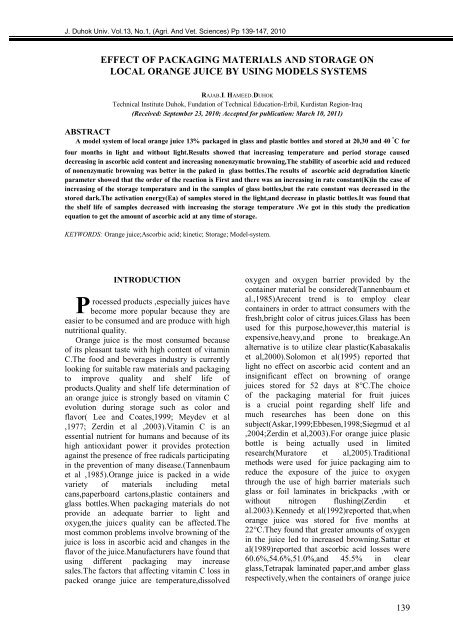The Influence Of Priming Two Cucumber Cultivar Seeds
The Influence Of Priming Two Cucumber Cultivar Seeds
The Influence Of Priming Two Cucumber Cultivar Seeds
You also want an ePaper? Increase the reach of your titles
YUMPU automatically turns print PDFs into web optimized ePapers that Google loves.
J. Duhok Univ. Vol.13, No.1, (Agri. And Vet. Sciences) Pp 139-147, 2010<br />
EFFECT OF PACKAGING MATERIALS AND STORAGE ON<br />
LOCAL ORANGE JUICE BY USING MODELS SYSTEMS<br />
RAJAB.I. HAMEED.DUHOK<br />
Technical Institute Duhok, Fundation of Technical Education-Erbil, Kurdistan Region-Iraq<br />
(Received: September 23, 2010; Accepted for publication: March 10, 2011)<br />
ABSTRACT<br />
A model system of local orange juice 13% packaged in glass and plastic bottles and stored at 20,30 and 40 ° C for<br />
four months in light and without light.Results showed that increasing temperature and period storage caused<br />
decreasing in ascorbic acid content and increasing nonenzymatic browning,<strong>The</strong> stability of ascorbic acid and reduced<br />
of nonenzymatic browning was better in the paked in glass bottles.<strong>The</strong> results of ascorbic acid degradation kinetic<br />
parameter showed that the order of the reaction is First and there was an increasing in rate constant(K)in the case of<br />
increasing of the storage temperature and in the samples of glass bottles,but the rate constant was decreased in the<br />
stored dark.<strong>The</strong> activation energy(Ea) of samples stored in the light,and decrease in plastic bottles.It was found that<br />
the shelf life of samples decreased with increasing the storage temperature .We got in this study the predication<br />
equation to get the amount of ascorbic acid at any time of storage.<br />
KEYWORDS: Orange juice;Ascorbic acid; kinetic; Storage; Model-system.<br />
P<br />
INTRODUCTION<br />
rocessed products ,especially juices have<br />
become more popular because they are<br />
easier to be consumed and are produce with high<br />
nutritional quality.<br />
Orange juice is the most consumed because<br />
of its pleasant taste with high content of vitamin<br />
C.<strong>The</strong> food and beverages industry is currently<br />
looking for suitable raw materials and packaging<br />
to improve quality and shelf life of<br />
products.Quality and shelf life determination of<br />
an orange juice is strongly based on vitamin C<br />
evolution during storage such as color and<br />
flavor( Lee and Coates,1999; Meydev et al<br />
,1977; Zerdin et al ,2003).Vitamin C is an<br />
essential nutrient for humans and because of its<br />
high antioxidant power it provides protection<br />
against the presence of free radicals participating<br />
in the prevention of many disease.(Tannenbaum<br />
et al ,1985).Orange juice is packed in a wide<br />
variety of materials including metal<br />
cans,paperboard cartons,plastic containers and<br />
glass bottles.When packaging materials do not<br />
provide an adequate barrier to light and<br />
oxygen,the juice , s quality can be affected.<strong>The</strong><br />
most common problems involve browning of the<br />
juice is loss in ascorbic acid and changes in the<br />
flavor of the juice.Manufacturers have found that<br />
using different packaging may increase<br />
sales.<strong>The</strong> factors that affecting vitamin C loss in<br />
packed orange juice are temperature,dissolved<br />
oxygen and oxygen barrier provided by the<br />
container material be considered(Tannenbaum et<br />
al.,1985)Arecent trend is to employ clear<br />
containers in order to attract consumers with the<br />
fresh,bright color of citrus juices.Glass has been<br />
used for this purpose,however,this material is<br />
expensive,heavy,and prone to breakage.An<br />
alternative is to utilize clear plastic(Kabasakalis<br />
et al,2000).Solomon et al(1995) reported that<br />
light no effect on ascorbic acid content and an<br />
insignificant effect on browning of orange<br />
juices stored for 52 days at 8°C.<strong>The</strong> choice<br />
of the packaging material for fruit juices<br />
is a crucial point regarding shelf life and<br />
much researches has been done on this<br />
subject(Askar,1999;Ebbesen,1998;Siegmud et al<br />
,2004;Zerdin et al,2003).For orange juice plasic<br />
bottle is being actually used in limited<br />
research(Muratore et al,2005).Traditional<br />
methods were used for juice packaging aim to<br />
reduce the exposure of the juice to oxygen<br />
through the use of high barrier materials such<br />
glass or foil laminates in brickpacks ,with or<br />
without nitrogen flushing(Zerdin et<br />
al.2003).Kennedy et al(1992)reported that,when<br />
orange juice was stored for five months at<br />
22°C.<strong>The</strong>y found that greater amounts of oxygen<br />
in the juice led to increased browning.Sattar et<br />
al(1989)reported that ascorbic acid losses were<br />
60.6%,54.6%,51.0%,and 45.5% in clear<br />
glass,Tetrapak laminated paper,and amber glass<br />
respectively,when the containers of orange juice<br />
931



